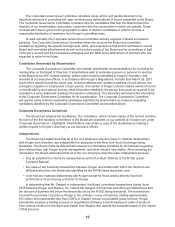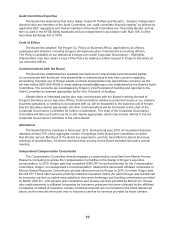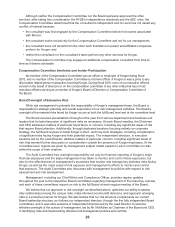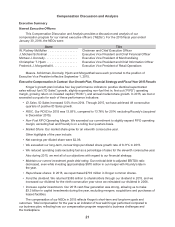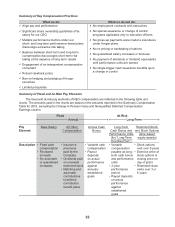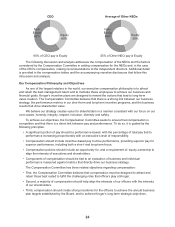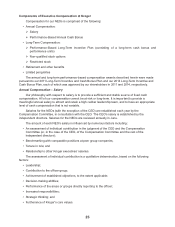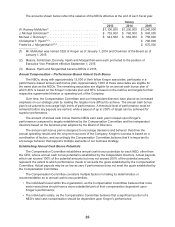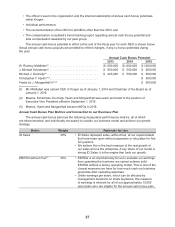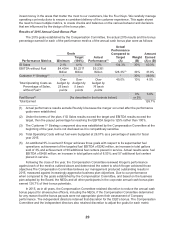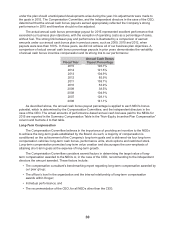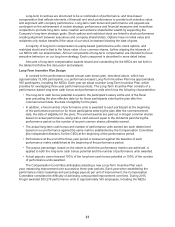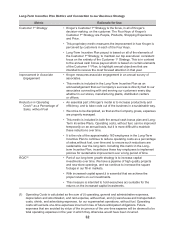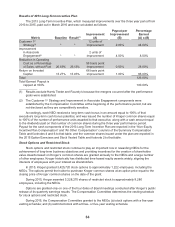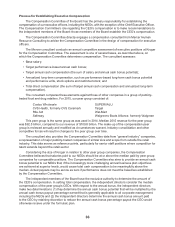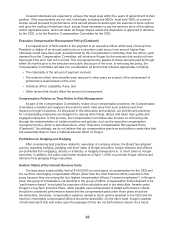Kroger 2015 Annual Report Download - page 30
Download and view the complete annual report
Please find page 30 of the 2015 Kroger annual report below. You can navigate through the pages in the report by either clicking on the pages listed below, or by using the keyword search tool below to find specific information within the annual report.
28
Metric Weight Rationale for Use
Customer 1st Strategy 30% • Kroger’s Customer 1st Strategy is the focus, in all of Kroger’s
decision-making, on the customer. The “Four Keys” of
Kroger’s Customer 1st Strategy are People, Products,
Shopping Experience and Price.
• This proprietary metric measures the improvement in how
Kroger is perceived by customers in each of the Four Keys.
• Annual cash bonus payout is based on certain elements of
the Customer 1st Plan, to highlight annual objectives that are
intended to receive the most focused attention in that year.
Total Operating Costs
as a Percentage of
Sales, without Fuel(2)
10% • An essential part of Kroger’s model is to increase
productivity and efficiency, and to take costs out of the
business in a sustainable way.
• We strive to be disciplined, so that as the Company grows,
expenses are properly managed.
Total of 4 Metrics 100%
Fuel Bonus 5% “Kicker” • An additional 5% is earned if Kroger achieves three goals
with respect to its supermarket fuel operations: targeted fuel
EBITDA, an increase in total gallons sold, and additional
fuel centers placed in service.
• The fuel bonus was added to the annual cash bonus plan
as an incentive to encourage the addition of fuel centers
at a faster rate, while maintaining fuel EBITDA and fuel
gallon growth.
• The fuel bonus of 5% is only available if all three measures
are met. If any of the three fuel goals are not met, no portion
of the fuel bonus is earned.
(1) EBITDA is calculated as operating profit plus depreciation and amortization, excluding fuel and
consolidated variable interest entities.
(2) Total Operating Costs is calculated as the sum of (i) operating, general and administrative expenses,
depreciation and amortization, and rent expense, without fuel, and (ii) warehouse and transportation
costs, shrink, and advertising expenses, for our supermarket operations, without fuel.
The use of these four primary metrics creates checks and balances on the various behaviors and
decisions that impact the long-term success of the Company. The ID Sales, EBITDA without fuel and
Customer 1st Strategy metrics are weighted equally to highlight the need to simultaneously achieve all
three metrics in order to maintain our growth.
We aligned the weighting of ID Sales and EBITDA without fuel metrics to emphasize sales growth
balanced with the focus on profit. Kroger’s business is not sustainable if we merely increase our ID Sales,
but do not have a corresponding increase in earnings. Furthermore, payouts in the ID Sales and EBITDA
without fuel segments are interrelated. Achieving the goal for both the ID Sales and EBITDA without fuel
results in a higher percentage payout on both elements. Achieving the target on one, but not the other will
limit the payout percentage on both.
By supporting the Customer 1st Strategy and the Four Keys, we will better connect with our
customers. Our unique competitive advantage is our ability to deliver on the Four Keys, which are the
items that matter most to our customers, and it is that multi-faceted achievement that we believe drives
our ID Sales growth.
As we strive to achieve our aggressive growth targets, we also continuously aim to reduce our
operating costs as a percentage of sales, without fuel. Productivity improvements and other reductions
in operating costs allow us to reduce costs in areas that do not matter to our customers so that we can


